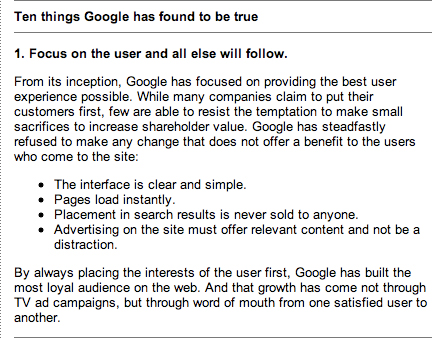Selling by Not Selling
Let’s start with a little quiz we’ve used in some of our presentations to stakeholders: What search engine do you use? Show of hands…
- Who uses Lycos?
- Who uses Google?
- Who uses Ask?
- Who uses Excite?
We bet most of you answered Google. Now ask yourself this: Why do you use Google? What do you like about using Google? What do your friends and family like about using Google? Do you remember how you first found out about Google?
Thinking… Thinking… Thinking… Got your answers? Great!
We’ve gone through this exercise many times, with many different groups, in many organizations. Your answers probably include a mix of some of those we’ve heard before:
- It’s easy to use.
- It’s fast.
- It’s usable.
- It has a nice, simple home page.
- It gives me what I want.
- It’s accurate and finds results quickly.
- It’s focused and does not get too far away from its core value—and that’s search.
Well, as Figure 1 shows, on the Google Corporate Information page, under “Our Philosophy,” there’s a list of “Ten things Google has found to be true,”![]() —and the number one thing is “Focus on the user and all else will follow.”
—and the number one thing is “Focus on the user and all else will follow.”

It’s intriguing that Google, which some would say is an engineering-centric company, has a philosophy that elevates the importance of user experience above all else. Of course, this explains why Google search is so easy to use and widely imitated. Perhaps this also says something about why Google is such a strong business performer.
Now, let’s take a step back for a moment.
The purpose of our quiz was not to focus on how much we love Google products and services or look too deeply at their approach to design and user experience. Rather this exercise was meant to do the following:
- Entertain and connect with the audience during our presentations.
- Get people to think about a product experience they enjoy as users—independent of their positions in their companies, whether managers, designers, usability professionals, product managers, or engineers—and explain to us why they enjoy the Google service. (Google is a well-recognized, top-of-mind example. Most people have a positive Google experience to share. However, we could just as easily use another example.)
- Talk about some of the reasons why Google offers a positive user experience.
- Touch on themes that are important to achieving a great UX—design, functionality, corporate culture, innovation, and simplicity—without talking about usability directly.
- Then, finally, start talking about user experience, usability, and a user-centered design (UCD) process.
In the past, we might have gone straight to presenting a UCD process diagram that’s full of methods and tools and talked about the process we wanted stakeholders to accept—and hoped they’d come to believe in strongly. However, our experience has shown that doing this can be too overwhelming for such an audience and, if we use too much UX jargon, make our presentation difficult for our audience to comprehend. This is especially true for stakeholders who, while they may have heard terms like UX or usability, don’t really understand what they mean.
Tip—Start with people’s own product experiences, then work toward communicating UX concepts.
How Are You Selling UX Today?
Now, think about how you’re selling UX today. What tools and techniques do you use to explain what you do and how you do it? What language do you use? Think about how you can leverage the language of others. Yes, it’s true… A focus group is different from a usability test. But perhaps you might describe a usability test as a different kind of focus group to help a product manager understand its real benefits.
What Are the Barriers to the Adoption of UX?
At the UPA 2008 conference, we facilitated a workshop titled “Make Yourself Heard! Selling User Experience in Your Organization.” Here are some of the barriers people told us they encountered when attempting to sell UX:
- lack of management support
- developers’ seeing UX as an obstacle rather than seeing its benefits
- enterprise solutions dictating the UX, giving little opportunity for improvements
- being a sole UX person, or lone warrior, in an understaffed organization, in which it’s difficult to inject best practices and optimize UX activities
- increasing demand for UX in an organization that, while it understands the value of UX in general, allocates no additional budget to match the demand
- pressure on UX when staff alignments and budgeting occur
- not allowing enough time to include UX, because it “slows down the process”
- multiple UX teams with different agendas, styles, and leadership
- walking the fine line between providing valuable feedback and not stepping on people’s toes—for example, avoiding political backlash, developer resistance, and bruising designers’ egos
- having difficulty selling more advanced and expensive techniques when people expect usability to be fast and cheap
- approval of UX tools or techniques too late in the development process to make a difference
How can you break through these barriers? Here are some ways we’ve found to be effective:
- Find key supporters and advocates who can speak for UX.
- Get involved in the requirements gathering stage of the product development process.
- Set up interactive workshops to discuss the role of UX on projects.
- Create a center for excellence to help spread information about UX across teams and the entire organization.
- Show horror video clips from usability test sessions to executives.


